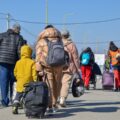Will increasing insecurity lead us beyond polarisation?
Will increasing insecurity lead us beyond polarisation?
The 2020s could be described as the ‘decade of crises’. Is there hope to move beyond polarisation in the light of emerging crises?
This article was written in preparation for our round table on ‘A Pandemic of Polarisation’.
The decade of crises
Following many years of polarisation, the 2020s could be described as the ‘decade of crises’. From the COVID-19 pandemic, through the cost-of-living crisis, to war in Eastern Europe, the mounting concerns increase insecurity in Europe to levels unknown for nearly a century. Considering what happens, many ask now: Will the growing insecurity decrease polarisation, or will we become even more divided than before?
Two possible directions
It is not easy to assess which direction will dominate in the coming years. On the one hand, we may observe worrying signs around the anti-vaccination movements and misinformation concerning the Russian invasion of Ukraine. On the other, some early studies indicate that affective polarisation decreased during the first years of the 20th century’s third decade.[1] The Atlantic’s prognosis for the 2020s suggests that the following years might bring diversification of both left and right, more moderate populism, fall out of the grace of populist governments, and the return of liberal democracy’s allure.[2] The mass mobilisation across political boundaries of individual families to host under their roof over 2 million Ukrainian refugees at the time of writing also provides glimmers of hope.[3] [4]
The economic troubles
The economic effects of the mounting crises may have a long-term impact on the potential for polarisation. An uptake of inflation has followed the economic downturn during the pandemic. The IMF warns that the Russian invasion will have serious economic consequences too. The early signs of that are visible in the rapid increases in energy and commodities prices,[5] and the global shortages of food may follow.[6]
The impact of economic security on polarisation
The levels of economic security have been linked to the potential for polarisation. Some studies argue that financial distress might reduce partisan hostility, provided that there is a cross-partisan consensus.[7] [8] Other studies claimed that economic security correlates with the combination of strong belief and strong religious practice, leading to an increase in religion-based political cleavages.[9] The recent crises seem to disrupt this combination. On the one hand, insecurity, including economic[10] and health[11] insecurity, might increase religious belief.[12] On the other hand, the COVID-19 pandemic led to the drop in religious practice,[13] [14] which some predict not to return to the same levels later on.[15] [16] These studies could suggest that we may expect a decline in polarisation.
Leadership and inequality may pose risks
However, several risks emerge in light of these studies. First, while economic distress may decrease partisan hostility where cross-party consensus exists, it is not as clear what happens without that consensus. Lack of consensus combined with economic distress risks deepening polarisation,[17] especially if supported by overarching narratives and ideologies, for example nationalism and scapegoating, as visible in such examples as the role of antimigration rhetoric in Brexit in the UK,[18] reactions to sanctions in Russia,[19] or the ideas of ‘great replacement’ in the 2022 presidential elections in France.[20] [21] Second, a drop in religious practice may change the points of reference for the faithful, from the local religious community to the broader faith community, increasing the importance of religious leadership. Two recent examples may be given with regard to the Russian invasion of Ukraine. On the one hand, the support for invasion by Patriarch Kirill of Moscow split the Orthodox Church.[22] [23] On the other hand, the ‘soft’ stance of the Vatican, the careful choice of words by Pope Francis, and his video call with Patriarch Kirill are viewed by some as highly problematic.[24] [25] [26] Third, economic inequality has been correlated with class[27] and political polarisation.[28] If financial burdens are unequally distributed, the growing group of underprivileged may undermine the tentative unification.
We need coalition-building
While hopeful signs point to a possible move beyond polarisation in the light of emerging crises, multiple risks remain. We need to work on coalition-building beyond class, political, and religious boundaries to overcome these risks. Equally shared economic burdens, cross-party consensus, and united religious leadership seem to be the most critical elements for decreasing polarisation in the coming years.
You can use the free EARS Dashboard to learn more about trends and developments on the topic of religion and society. Hundreds of article summaries from all over the world were added in the past month!
Sources
[1] Affective polarization did not increase during the COVID-19 pandemic
[2] Predictions for the 2020s – The Atlantic
[3] ‘We understand what war means’: Poles rush to aid Ukraine’s refugees | Ukraine | The Guardian
[4] Straż Graniczna on Twitter: “#Pomagamy🇺🇦
[5] IMF Staff Statement on the Economic Impact of War in Ukraine
[6] Ukraine War Threatens to Cause a Global Food Crisis – The New York Times (nytimes.com)
[7] Frontiers | Political Polarization During the COVID-19 Pandemic
[8] A Rare Moment of Cross-Partisan Consensus: Elite and Public Response to the COVID-19 Pandemic in Canada | Canadian Journal of Political Science/Revue canadienne de science politique | Cambridge Core
[9] Economic Security and the Strength of Religious Cleavages
[10] Does Economic Insecurity Predict Religiosity? Evidence from the European Social Survey 2002–2014
[11] Full article: Searching for comfort in religion: insecurity and religious behaviour during the COVID-19 pandemic in Italy
[12] How COVID-19 Has Strengthened Religious Faith | Pew Research Center
[13] Take Me to (the Empty) Church? Social Networks, Loneliness and Religious Attendance in Young Polish Adults During the COVID-19 Pandemic | SpringerLink
[14] Will COVID-19 Cause a Religious Recession? – Religion & Diplomacy
[15] Here’s Who Stopped Going to Church During the Pandemic… | Christianity Today
[16] The world’s religions face a post-pandemic reckoning | The Economist
[17] Frontiers | Political Polarization During the COVID-19 Pandemic
[18] Taking back control? Investigating the role of immigration in the 2016 vote for Brexit – Matthew Goodwin, Caitlin Milazzo, 2017 (sagepub.com)
[19] What do ordinary Russians really think about the war in Ukraine? | EUROPP (lse.ac.uk)
[20] French Presidential Election 2022: The ‘great replacement’ is a xenophobic conspiracy theory – InfoMigrants
[21] France’s Pécresse comes under fire for reference to far-right conspiracy theory – POLITICO
[22] Patriarcha Moskwy w kazaniu broni wojny Putina. Mówi też o “paradach gejów” – rp.pl
[23] Analysis: Ukraine invasion splits Orthodox Church, isolates Russian patriarch | Reuters
[24] Tomasz Terlikowski: Dialog z kimś, kto akceptuje zbrodnie Putina mija się z celem – rp.pl
[25] Tomasz P. Terlikowski: Potępienie, na które nie stać Watykanu – rp.pl
[26] Local churches shun Vatican’s moderate stance on Russia – ABC News (go.com)
[27] The polarizing effect of economic inequality on class identification: Evidence from 44 countries – ScienceDirect
[28] Income Inequality and Political Polarization: Time Series Evidence Over Nine Decades – Duca – 2016 – Review of Income and Wealth – Wiley Online Library






